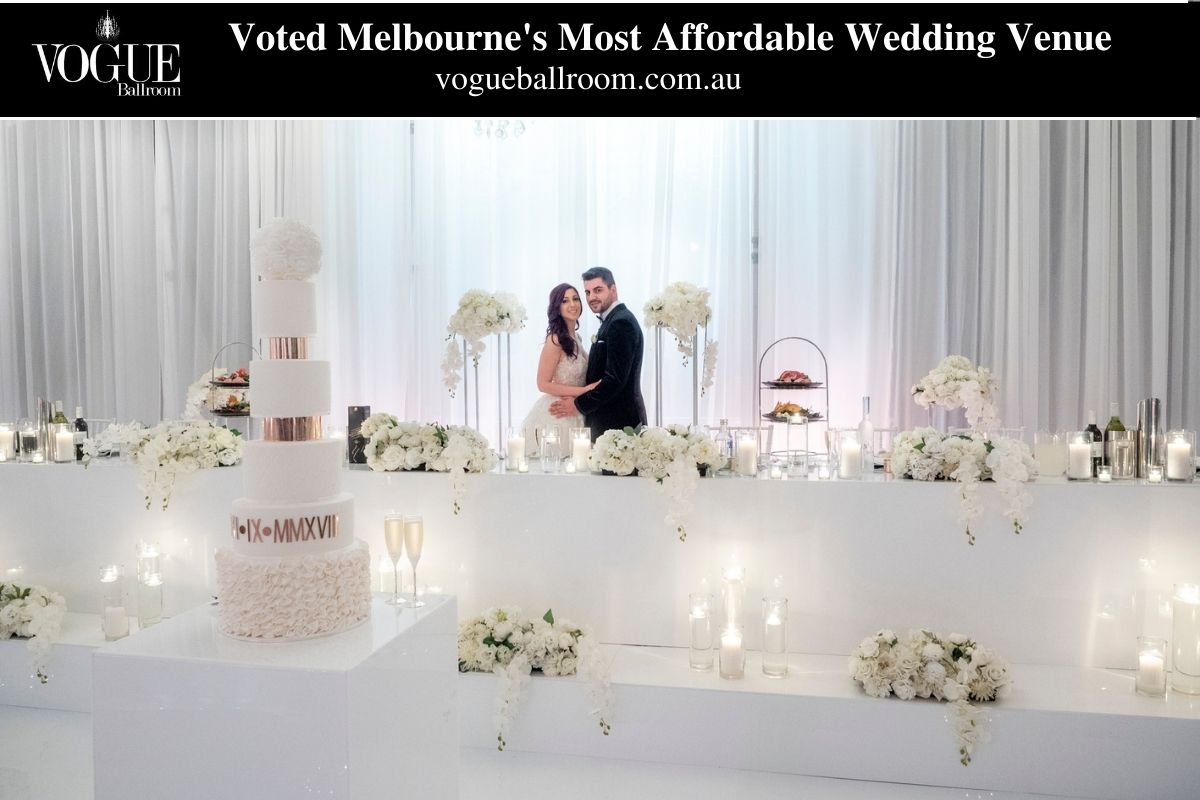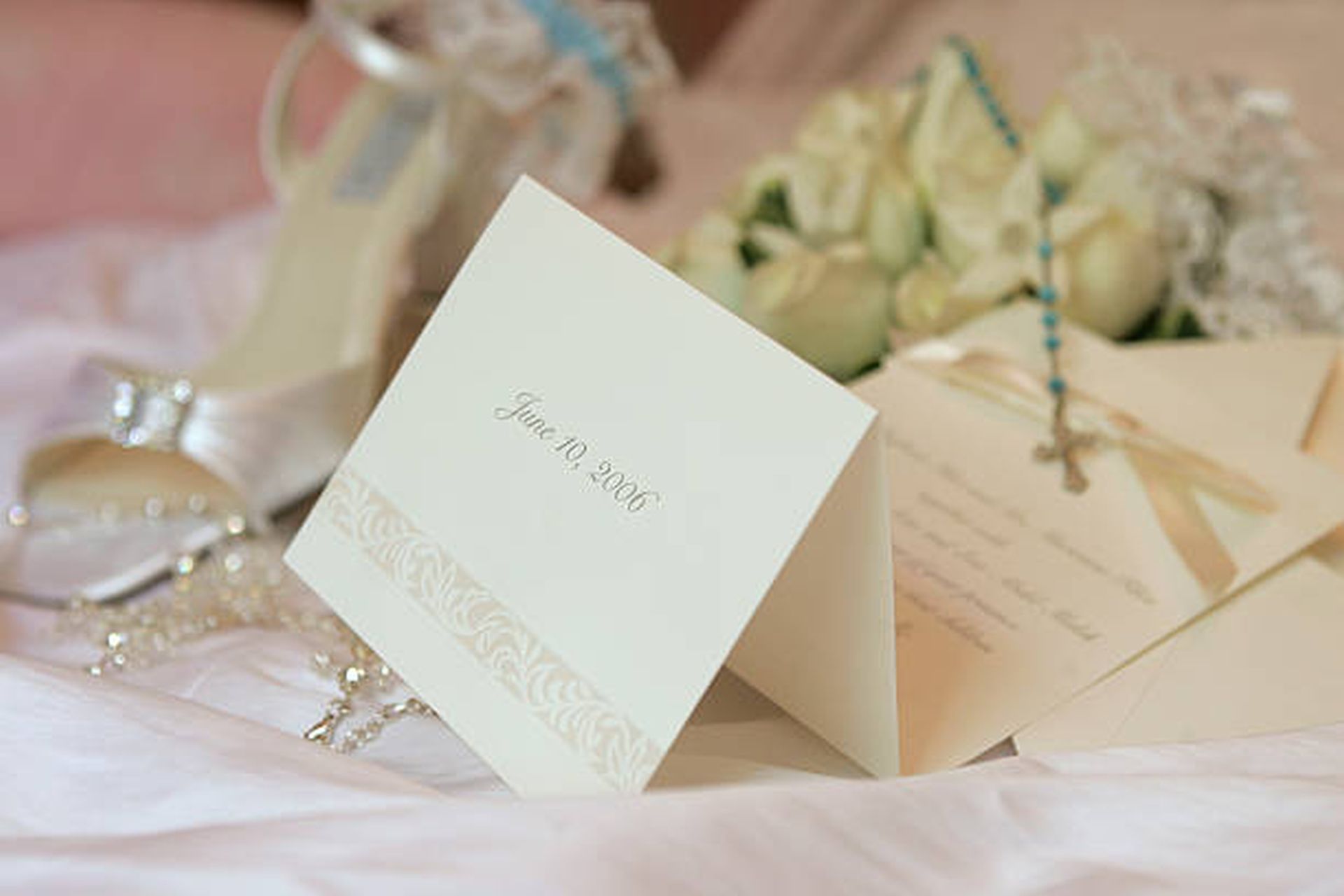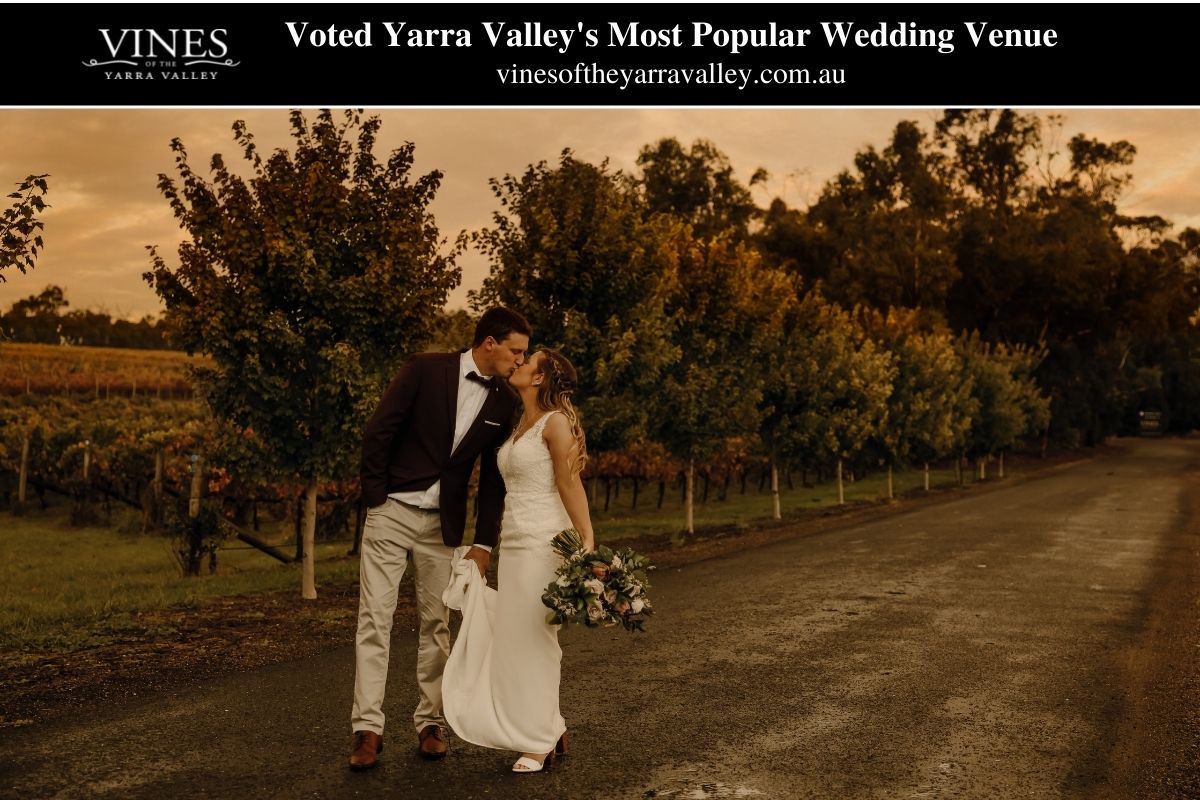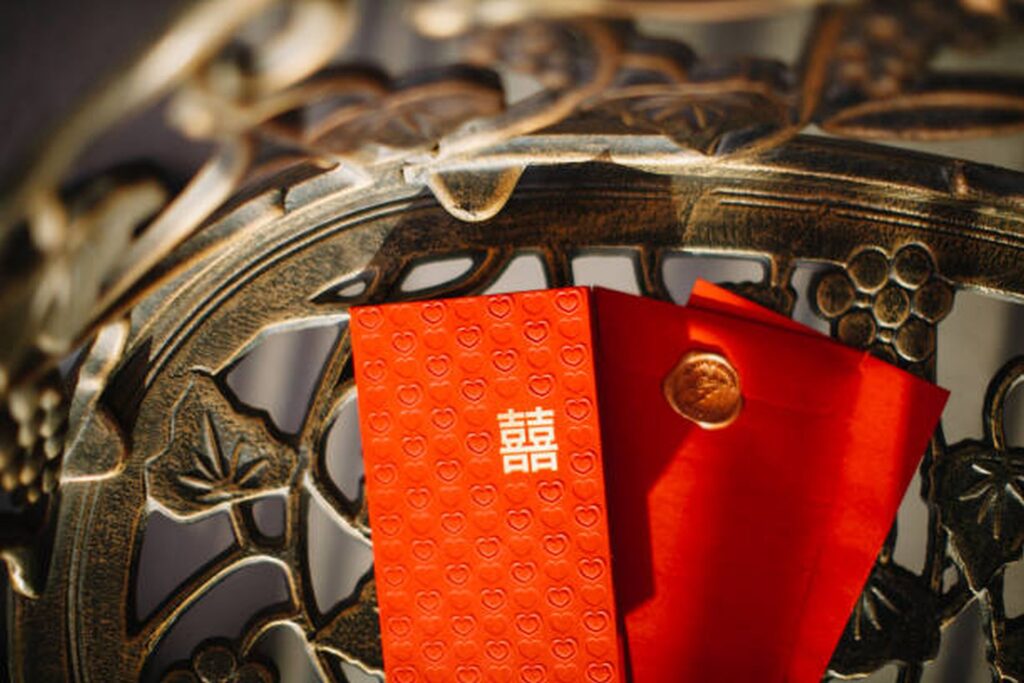The text for wedding invitations may not inspire as much originality as choosing the perfect paper, font, or colour palette. Even the most beautiful wedding invites need to have a functional purpose: providing relevant information to the invited guests.
Your wedding invitations should not only provide the essential details for your big day, but also provide a glimpse into your personal style as a couple. Details such as who is getting married, who is hosting, and when and where the ceremony and reception will take place should all be included. (Spoiler alert: the wedding website is also where you'll share details like the registry and the bridal party.) While we'll be looking at some standard examples of invitation wording shortly, don't be afraid to veer from the norm if your wedding will have a more casual, contemporary, or unconventional vibe.
It's time to tackle the wedding invitation wording now that you've decided on the stationery. It's up to you whether the phrasing is formal and stuffy or fresh and fun, but there are several necessities that must be covered any way.
When sending out wedding invitations, it's common practise to exclude the guest of honor's last name if the event is being hosted by the guest of honor's parents. However, their entire name should be included if they have a surname that is distinct from that of their parents. If the host's parents are the person's partner's parents, then the person's surname should be provided as well.
We recommend our traditional wedding invites and wedding invitation wording if you want to give your guests an accurate first impression of your wedding's theme and aesthetic. Use our classic wedding invitation wording for a formal wedding or a wedding hosted by the bride or groom's parents; all of our invites are customizable. Who knew there were so many ways to phrase a formal invitation? Fortunately, we have some suggestions for more conventional phrasing for wedding invitations. Check out our informal wedding invitation wording examples if you feel like the aforementioned selections are too stuffy for your big day.
Looking for the ultimate Wedding Reception Venue in Melbourne? Look no further, Boutique events group is here.

Wedding Invitation Wording Etiquette
You've decided on the look of your stationery (if you haven't already, take a look at some of our favourites) and now you need to figure out what to put on your wedding invitations. Date, time, and place are required details, but what more should you include? There are several factors to think about when choosing a wedding invitation format, such as how to incorporate everything visitors will need to know.
Include a separate insert with your wedding website's URL so that visitors can easily access information about the big day and the registry (especially since including registry details on the invitation itself is not always well-received). Plus, guests can RSVP electronically through our wedding websites, allowing you to monitor attendance in real time.
In the off chance that wasn't enough. Your guests can see the same colours, patterns, and designs on your wedding website as they did in the invitation they received in the mail. This provides your guests with a unified experience that will help them appreciate your aesthetic (in both digital and physical forms) and become psyched for your wedding.
In addition, you can use whatever text you like for your wedding invitations instead of the standard fare. We all know that wedding invitations (and the titles commonly used on them) are sexist and restricted to one gender. It is perfectly OK to refer to your guests by their given names without prefixing them with "Mr." or "Mrs." Even if you prefer for a more conventional approach, you may still include all guests regardless of their gender by using the title "Mx." on the invitations. If you're going to do something, make sure it's something you'd actually do (it's your wedding, after all).
For a comprehensive rundown of what should be included in wedding invitation wording, please refer to the list below.
- The Hosts' Names (titles optional)
- Insisting that you be there at the wedding
- Who the happy couple are
- These are the current time and date
- The places (name of the venue and address)
- Data on the Reception (location and time)
- Standards of Dress
- Details on a Wedding-Related Website (optional to include on separate insert)
Traditional elements of wedding invitation language
- Invitations to weddings in the traditional style are always written in the third person.
- The bride's name is listed first, followed by the groom's.
- Words are used to indicate the times and dates.
- the use of given names and middle names
- Usually composed by the parents of the bride and groom.
Advice for the conventional wedding invitation
- Add this line to indicate the wedding host (parents or the couple)
- An RSVP line for your wedding.
- The complete couple’s names
- When will the ceremony be held?
- Specifics about the Location Where This Event Will Take Place
- Details about the reception
- The end of the RSVP period
- RSVP information

Wordings in Wedding Invitations
Hosts Names
Even at the most formal ceremonies, it is customary to list the parents of the bride as the hosts on the invitation. Regardless who pays, both parents should be listed as hosts. An increasing number of couples are choosing to hold their own weddings or weddings that include the couple's parents. Not sure how you want your wedding stationery to look? Check out our list of 28 Wedding Invitation Ideas to help you choose.
What If Any Parents are Deceased?
It may be important to make some changes in order to properly honour a parent who has passed away, as they can no longer serve in the hosting role. Change the wording to include deceased parents.
How to Address Divorced or Remarried Parents
When writing up the list of hosts, if the bride or groom's parents are divorced, you can simply write their names on separate lines. Put the stepparent's name on the same line as the biological parent's. Though it appears complicated at first, adding only a few extra lines of code is all that's needed.
There are a variety of approaches you can choose to express your gratitude for your visitors' time and company. The usage of the British form of "honour" suggests that the event will be held in a religious building.
They should be given prominent placement, even if not on the host line. Obviously, this information will be included on the wedding invitation, but you might be wondering: Which name goes first? In conventional ceremonies, the bride is announced before the groom. The bride's entire name and any titles she may have are included on formal invitations given by the bride's parents; if the pair is hosting on their own, titles are not necessary.

Date and Time
Everything is planned out in detail in advance for the wedding. Include the year if you like. You can tell what time it is by saying something like, "half past five o'clock" or "o'clock." You can choose whether to use AM or PM. Numbers are acceptable for a casual wedding.
Location
If your wedding is being held at the home of the host, or if omitting the street address might cause confusion, the street address is not required. In either scenario, the exact location must be typed out.
Dress Code
If you want to provide a dress code on your wedding invitation, you should do so at the bottom right corner. The invitation itself serves as a dress code indicator, so there's no need to specify. For example, if the invitation is expensive, the recipients could think it's a black-tie affair, whereas if it's simple, they'll realise it's casual.
RSVP Card
Most couples choose to have guests reply on a second card and send it back to them after the wedding. You can also have your guests RSVP through a wedding website. It's best to include the destination on a separate card (like an RSVP card) and tell guests to answer there if you want to know whether or not they can make it.
Sponsored by One Set of Parents
One guest's parents are included on the invitation, so it is unnecessary to list that guest's last name (unless they have a different last name than their parents). Put the other person's full name on the line below. Gender nonconforming and same-sex couples should also adhere to these standards. The names of the parents who are throwing the party come first, then those of their children, and finally those of their children's significant others. Avoid abbreviations where possible; write "do not" instead of "don't." Those who receive your wedding invites should not get the impression that you rushed through the process.
Who Hosts?
The opening line of the wedding invitation is notoriously tricky to write because it serves as a conduit for not only the host but also the couple's recognitions. Historically, the bride's family has traditionally hosted (and therefore paid for) the wedding. This was especially common before the advent of blended families and when women were marrying at younger ages. Nowadays, weddings are hosted by a group of people close to the happy couple.
Check out our exclusive list of Wedding Invitation Ideas to help you choose the perfect invitation for your guests.

Whose address is the return?
Not the happy couple's but the event hosts' address should be printed on the envelope flap as the return address. In a formal return address, a name is not typically included. To this address should be sent gifts from absent guests.
Whose address is on the reply envelope?
You can urge your guests to answer quickly by having your name and address written on the front of the Response Card envelope. The customary answer envelope includes the host's name and address. You are free to use whatever address is most practical for you.
There are some instances where sticking to tradition is the better choice, even if putting some current and contemporary touches into various aspects of your wedding can make the day unquestionably cool. If you share my belief that the tried-and-true always triumphs, then listen to your instincts and select a classic style, especially for your wedding stationery. Despite their retro vibes, the following invitation sets are perfect for modern nuptials. The timeless appeal of classic stationery can be attributed to its many design elements, such as its calligraphy, exquisite typefaces, tried-and-true printing procedures, and muted colour palette.
FAQs About Wedding Invitation
It is proper to address a wedding invitation to a person's full name. For those using an inner envelope, then the outer envelope can omit them, while the inner envelope has the full names of everyone invited, but for those who only have one envelope, it should be addressed to everyone in full.
The name of the bride always precedes the groom's name. Formal invitations issued by the bride's parents refer to her by her first and middle names, the groom by his full name and title; if the couple is hosting by themselves, their titles are optional.
Last names aren't needed for the bride or groom if their parents are listed on the invitation. Typically, wedding invitations include the first and middle names of both the bride and groom, and the first, middle and last names of the bride and groom if parents aren't listed.
Traditionally the name of the bride always precedes the groom's name. Formal invitations issued by the bride's parents refer to her by her first and middle names, the groom by his full name and title; if the couple is hosting by themselves, their titles are optional.
A wedding invitation is issued by the host(s). The hosts' name(s) are spelled out and include middle names and titles. Doctor should be spelled out, unless the name would be too long to fit on one line.
Conclusion
Even the most visually stunning wedding invitations must serve a purpose. Include the names of the couple getting married, the names of the people hosting the ceremony and reception, the date and time of the ceremony and reception, and any other relevant information. If you want your wedding to have a more relaxed or unique atmosphere, you shouldn't be scared to deviate from tradition. The perfect wedding invitation must include the following information. You must give the date, but what else is important?
The wording of your wedding invitations is entirely up to you; you don't have to stick to the traditional fare. In the traditional manner, the word "you" is never used on the wedding invitation. More and more young couples are opting to host either small, intimate ceremonies or larger celebrations that include extended family and friends. There are numerous ways to show appreciation for your guests' attendance at your wedding on the invitation. Make sure to include this sentence to thank the wedding host (parents or the couple).
Your wedding venue must be provided in full if it is being hosted in the home of the host or if leaving out the street address could lead to misunderstandings. The bottom right corner of your wedding invitation is the perfect place to include a dress code. Do not use "don't" when "do not" will do, and avoid abbreviations whenever feasible. Classic stationery has stood the test of time because of its varied design aspects.
Content Summary
- Even the most beautiful wedding invites need to have a functional purpose: providing relevant information to the invited guests.
- It's time to tackle the wedding invitation wording now that you've decided on the stationery.
- Use our classic wedding invitation wording for a formal wedding or a wedding hosted by the bride or groom's parents; all of our invites are customizable.
- Fortunately, we have some suggestions for more conventional phrasing for wedding invitations.
- You've decided on the look of your stationery (if you haven't already, take a look at some of our favourites) and now you need to figure out what to put on your wedding invitations.
- Date, time, and place are required details, but what more should you include?
- Change the wording to include deceased parents.
- When writing up the list of hosts, if the bride or groom's parents are divorced, you can simply write their names on separate lines.
- Put the stepparent's name on the same line as the biological parent's.
- The bride's entire name and any titles she may have are included on formal invitations given by the bride's parents; if the pair is hosting on their own, titles are not necessary.
- Everything is planned out in detail in advance for the wedding.
- Include the year if you like.
- If your wedding is being held at the home of the host, or if omitting the street address might cause confusion, the street address is not required.
- If you want to provide a dress code on your wedding invitation, you should do so at the bottom right corner.
- The invitation itself serves as a dress code indicator, so there's no need to specify.
- You can also have your guests RSVP through a wedding website.
- One guest's parents are included on the invitation, so it is unnecessary to list that guest's last name.
- Those who receive your wedding invites should not get the impression that you rushed through the process.
- The opening line of the wedding invitation is notoriously tricky to write because it serves as a conduit for not only the host but also the couple's recognitions.
- The bride's family has traditionally hosted (and therefore paid for) the wedding.
- Not the happy couple's but the event hosts' address should be printed on the envelope flap as the return address.
- You can urge your guests to answer quickly by having your name and address written on the front of the Response Card envelope.
- The customary answer envelope includes the host's name and address.
- If you share my belief that the tried-and-true always triumphs, then listen to your instincts and select a classic style, especially for your wedding stationery.

